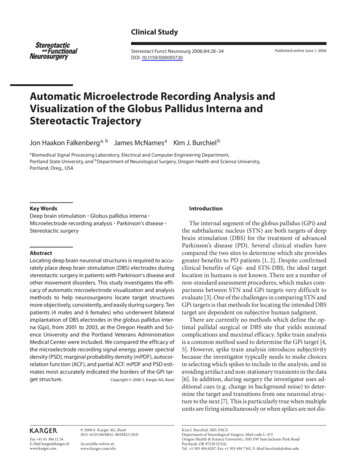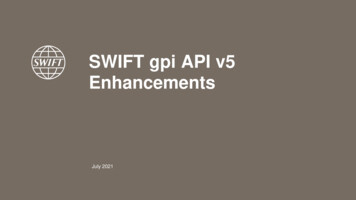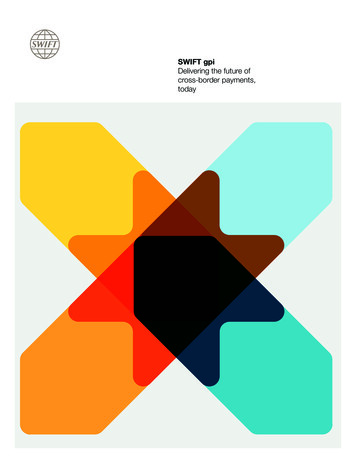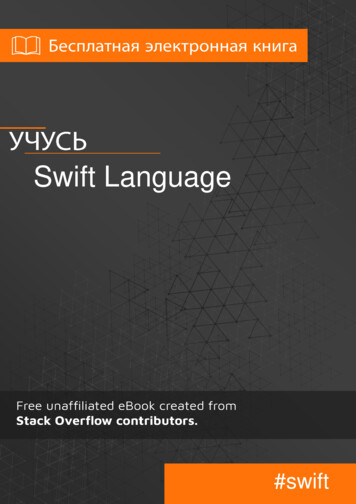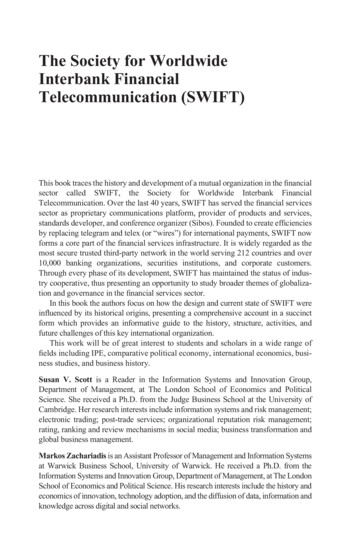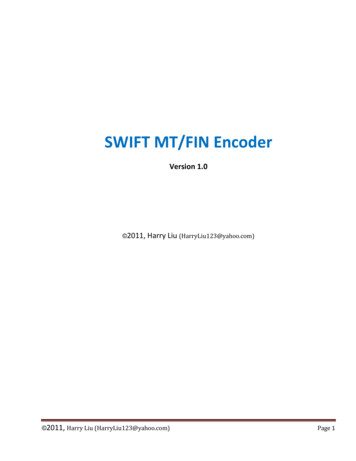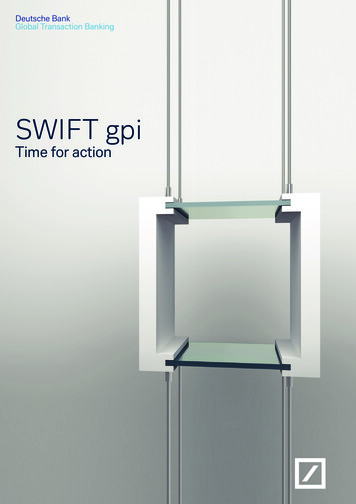
Transcription
Deutsche BankGlobal Transaction BankingSWIFT gpiTime for actionSWIFT gpi 1
ContentsForeword by Christian Westerhaus31.Transforming cross-border payments41.1The need for innovation41.2SWIFT gpi at a glance51.3Benefits for corporates61.4Benefits for financial institutions72.3.2SWIFT gpiHow SWIFT gpi works92.1V1: Delivering a new standard92.2V2: Designing digital transformation142.3V3: Exploring new technology15Implementation173.1Route to implementation173.2Alternative ways to leverage SWIFT gpi194.Adding value to SWIFT gpi205.The road ahead22
ForewordA little less conversationCorporate treasurers are putting financial institutionsunder mounting pressure to provide faster and moreconvenient cross-border payments.At the same time, they are demanding more granular data and transparency withthe respect to their payment credits and deductions, in order to inform their cashmanagement and working capital decisions. Banks, facing margin pressures andincreasing competition, are looking for ways to provide even better service to clients,while leveraging the latest technologies to deliver operational efficiencies.SWIFT’s global payments innovation (SWIFT gpi) initiative has the potential to solve allof these challenges. By connecting every party in a payment chain via a cloud solution,SWIFT gpi can improve the speed, transparency and traceability of payments. It can alsodeliver significant time and cost savings for banks over the longer term.But these benefits will only be fully realised if SWIFT gpi attains sufficient market reach,which requires a critical mass of banks to be fully up and running. As such, now is thetime for financial institutions to move from talk to action on SWIFT gpi. After a successfulyear-long trial period, we must work together to embrace the initiative’s live operationalmode – and ensure it becomes the new payment standard for correspondent banking.To this end, Deutsche Bank is part of the Vision Group for SWIFT gpi – comprisingthe ten largest transaction banks globally helping to shape the future of the initiative.We are a member of the Initiative Group, which represents a community of banks thatpromote SWIFT gpi to the industry, and contribute to its collaborative design of futuregpi functionality. Deutsche Bank is also one of the 33 validation banks participatingin a distributed ledger technology (DLT) proof-of-concept (PoC), since collaborativeinnovation is a key part of SWIFT gpi implementation.While co-ordinated action is a cornerstone of SWIFT gpi success, individual banksalso have an opportunity to carve out distinctive premium services and digital userexperiences around the initiative. Deutsche Bank, for example, is enriching non-gpi highvalue commercial EUR and USD payments with the relevant data to enable them to besent as SWIFT gpi payments. Not only will this deliver an immediate service enhancementto our financial institution and corporate clients, it will also help to raise awareness of thebenefits SWIFT gpi offers to all parties.SWIFT gpican improvethe speed,transparencyand predictabilityof paymentsThis whitepaper sets out to highlight precisely why this evolution in correspondentbanking is so important to financial institutions, corporates, and the payments industry.It also aims to provide a practical guide for implementation for those banks that are justbeginning their roll-out projects.We hope that you find this whitepaper both informative and insightful. To discuss anyof the issues raised in more detail, or to find out how your organisation can benefit fromSWIFT gpi, please don’t hesitate to get in touch with your relationship manager or localDeutsche Bank representative.Christian WesterhausGlobal Head of Clearing Products, Cash Management,Deutsche BankSWIFT gpi 3
Section One1. Transforming cross-border paymentsIn recent years, banks have invested significantamounts of time and money in enablingpayments to be made across the globe,through correspondent banking networks.Yet there are definite areas for improvement within the current cross-border paymentssetup. And as digital technologies infiltrate all areas of business life, these current challengesare becoming more of a pain point – for financial institutions and corporates alike.1.1 The need for innovationOne of the most common frustrations around cross-border payments today is that itcan take several days – in some cases up to a week – for funds to be credited to thebeneficiary’s account. This delay may be a result of market conditions, compliancerequirements, or the availability of correspondents in certain countries. Whatever thereason, it is a growing challenge, especially in the age of “on-demand” services.Fees are another issue. At present, banks charge for processing cross-border paymentsby deducting their fees from the original transaction amount – yet this makes itchallenging for corporates to reconcile received and invoiced amounts. FX fees canalso become obscured in a long and opaque transaction chain, so corporates are oftenuncertain as to the true cost of a transaction.Corporates issue a call for actionIn June 2017, six leading Swiss corporates issued an open letter stating theirsupport for SWIFT gpi and encouraging banks worldwide to adopt the initiative inorder to improve cross-border payments. Within the letter, they called for increasedtransparency and improvements to the investigation process, which can be timeconsuming and costly.These corporates see SWIFT gpi as “a long overdue, essential improvement of thecustomer needs for higher cross-border payment speed, transparency and end-toend tracking.” However, they also emphasise the need for an increasing number offinancial institutions to go live with SWIFT gpi, saying: “Banks cannot afford to notjoin the initiative and go live as soon as possible. Our expectation is that all of ourcross-border payments will be end-to-end SWIFT gpi payments in the future.”Source: pi/corporatesAn additional challenge is the lack of full and end-to-end information available aroundcross-border payments. On the one hand, remittance information has not been processedin a complete and unaltered manner, which has made it difficult for corporates toreconcile their payments. On the other hand, while banks benefit from clear and linearcommunication of messages surrounding a cross-border payment through the SWIFTnetwork, each participant is nevertheless limited to its own data environment. This meansthere is no communication across the entire value chain.Corporates also lament the inability to track the status of cross-border payments today.This not only results in poor predictability over cash flows, but can also complicate4SWIFT gpiSWIFT gpi is anindustry-widecollaborativeprogramme thataims to improvethe customerexperience incross-borderpayments
relations with suppliers if a payment is not received – a point made in an open letter fromsix major Swiss corporates in June 2017 (see box on page 4). Banks are also negativelyaffected by this lack of visibility and control over payments, since it results in more timeand resources being allocated to handling investigations and complaints.Against this backdrop, the need for innovation is clear.Payment landscape before SWIFT gpiSWIFT as main carrier of the messageCorporate systems1. Non receipt of funds2. Non receiptof funds3. Non receiptof funds4. Non receiptof dentBankCorporateSellerIssues1Credit to the beneficiary takes several days2Banks charge by deducting their fees from the original amount3Each participant in its own data and communication environmentTransparency of changes and end-to-endcommunication requiredCorporates cannot reconcile received andinvoiced amountsNo communication across the whole value chain4No tracking and status information on paymentNo information and traceability of payment statusNote: Country flags are for illustration purposes onlyFigure 1: How cross border payments work today1.2 SWIFT gpi at a glanceIn a nutshell, SWIFT gpi is an industry-wide collaborative programme that aims toimprove the customer experience in cross-border payments – and introduce new marketstandards by connecting all parties in the payment chain end-to-end.Importantly, by utilising a cloud-based solution, the initiative seeks to meet the goals ofimproving speed, transparency and traceability for end-customers, without compromisingbanks’ ability to meet their compliance obligations and market, credit and liquidity riskrequirements.The service leverages SWIFT’s secure and resilient global platform and any supervisedfinancial institution is eligible to participate. To ensure consistency, SWIFT gpi servicesoperate on the basis of business rules which are captured in multilateral service levelagreements (SLAs) between participating banks.To ensure a smooth adoption, the initiative is being rolled out in phases. The first phase,known as V1, was launched in February 2017 and sets a new standard in cross-borderpayments by increasing speed, providing transparency over fees, enabling end-to-endtracking and ensuring remittance information is unaltered. The second and third phases,V2 and V3, focus on addressing cost and inefficiencies in the current cross-borderpayments landscape, and creating a competitive value proposition in an increasinglycrowded marketplace (see page 9 of this whitepaper for more detail on each phase).SWIFT gpi 5
As of December 2017, 120 banks have signed up to SWIFT gpi. So far, 30 banks –including Deutsche Bank – are already live.1.3 Benefits for corporatesAlthough SWIFT gpi is a bank-led initiative, its design ultimately enables banks to helptheir corporate clients to grow and become more efficient.The most relevant phase of the SWIFT gpi initiative for corporates today is V1, since it focuseson responding to the current client challenges outlined on page 4 of this whitepaper. Briefly,V1 (as outlined in Figure 2) will introduce four major benefits for corporates:1. Same-day availability of funds, if received before the bank’s cut-off time2. Transparent fees – with regard to both deductions and exchange rates – thanks to allcharges being documented in the cloud3. End-to-end payment tracking and confirmation via the cloud4. The transmission of full and unaltered remittance information which will ease thereconciliation of paymentsIt is hoped that successful adoption of SWIFT gpi should therefore help corporates to:improve their ability to conduct and grow international business; lead to better supplierrelationships; and help them achieve greater treasury efficiencies.Payment landscape with SWIFT gpiSWIFT as main carrier of the messageView into SWIFT gpi cloud rate kCharacteristics1If received prior to receiving bank’s cut-off time, banks willcredit funds on day of receipt2CorrespondentBankBenefitsSame-day availability of fundsAny changes will be documented and replicable via the cloud 3Cloud will allow end-to-end communication End-to-end payments tracking4Unique end-to-end tracker reference will be generated for payment Unaltered remittance informationNote: Country flags are for illustration purposes onlyFigure 2: How cross border payments will work under SWIFT gpi6IntermediaryBankSWIFT gpiEnd-to-end transparency of feesCorporateSeller
1.4 Benefits for financial institutionsAlthough initial investment is required in SWIFT gpi, there are a range of immediate andlonger-term participation benefits that banks can reap. For example, by increasing thespeed, simplicity, convenience and transparency of payment services, SWIFT gpi helpsto provide an effortless payment environment for clients. In turn, this should encouragebetter client relationships and attract more business as clients, it is hoped, will choose toroute a higher volume of payments through banks offering SWIFT gpi services.Moreover, SWIFT gpi is an innovative service that bolsters the value proposition bankscan offer customers – and it demonstrates commitment to being a payments provider ofchoice in an increasingly competitive space. Deutsche Bank, for instance, is deliveringan immediate service enhancement to our financial institutions and corporate clients byenabling high-value commercial payments to go through SWIFT gpi. This enhancementwill see non-gpi payments automatically enriched with the relevant data that enablesthem to be sent via SWIFT gpi, so that clients can benefit from the new paymentfunctionality therein.Over the longer term, the developments introduced by SWIFT gpi may also manifestoperational advantages for banks. Thanks to the enhanced network and claim managementprocesses introduced in V1, for instance, banks can expect to reduce both their operationalcosts and time spent on investigating claims of non-receipt and handling complaints.Correspondent banks will also benefit strategically from the connection of all parties in thepayment chain in an end-to-end digital ecosystem, as well as leveraging new technologies– helping them to remain competitive and innovative, while also improving straight-throughprocessing (STP) rates. In turn, future cost savings and operational efficiencies will likelyarise from enhanced compliance practices and optimised intraday liquidity flows.SWIFT gpi 7
8SWIFT gpi
Section Two2. How SWIFT gpi worksSWIFT gpi is being rolled out in phases.Each phase looks to address distinct partsof the challenges faced by correspondentbanks in respect to cross-border payments.2.1 V1: Delivering a new standardThe first phase of SWIFT gpi implementation seeks to respond to evolving customerneeds and demands by improving the speed, transparency, and traceability of crossborder payments. V1 therefore focuses on Commercial Credit Transfers (gCCT) using theMT103 SWIFT message.In order to deliver on the transparency and traceability parts of the package, SWIFT hasintroduced the SWIFT gpi Tracker. Available to live gpi member banks since May 22,2017, SWIFT gpi Tracker acts rather like a UPS tracker, but for payments. It consists ofa cloud-based database that is securely hosted at SWIFT, designed to give end-to-endvisibility on the status of a payment transaction from the moment it is sent until it isconfirmed. This represents a milestone in correspondent banking, effectively connectingall parties in the payment chain of the correspondent banking ecosystem – leading tooperational efficiencies and better client service.This representsa milestone incorrespondentbanking,effectivelyconnecting allparties in thepayment chainThe Tracker can be updated by FIN Message or application programming interface (API)and accessed via a graphic user interface (GUI) – meaning it can easily be integrated intoother back-office systems at a bank.API technologyBanks are increasingly embracing Application Programming Interface (API) technology, spurred by changing clientdemands and regulatory change such as PSD2 – which will see third party providers (TPPs) given access to bankservices. Such technology allows banks to innovate without significant investment or risk, faster implement newproducts and services, and future-proof their businesses in the new digital world. APIs enable third parties to pull data,products and services from pieces of software that were not created by them, and embed these into their own systemsand products in real time in a secure and authenticated manner.Deutsche Bank believes that the future of banking will be based on platforms that connect TPPs, as well as serviceconsumers (financial institutions and corporate clients). API provides the following benefits: For providers: A bank can create and document an API once, and then direct data consumers to it over and over again For consumers: If an organisation has multiple applications or hosts that need access to the data, it doesn’t need to geta new database connection authorised for each oneKey characteristics of APIs include: Direct access: APIs provide data and services in programmatically reusable formats which make it easy to integratedata and services into internal systems. There is no need to convert data from one file format into another or tomanually bridge gaps between platforms. Timely data: APIs are capable of providing data that is refreshed much more frequently than can be achieved throughpulling, cleaning, and loading filesSWIFT gpi 9
From a technical perspective, the tracking functionality will be supported by a uniqueend-to-end transaction reference (UETR) included in the header of the MT103 (field 121)in addition to the gpi service code (field 111). The UETR (see box below for more detail)means that each party in the payment chain will be able to confirm their position, makingit possible for others in the chain to identify where the payment is in the lifecycle.While protocols are in place to ensure privacy around transactions, it will be possible tosee where a payment has been held up, for example. In the name of transparency, and toenhance self-service, Deutsche Bank is making it possible for its financial institutions andcorporate clients to access the Tracker themselves, via Deutsche Bank Cash Inquiry (seepage 20 for more details).End-to-end visibility across the whole payments chain is also reliant on the involvementof payments market infrastructures, which play a key role in the journey of a crossborder payment and are often responsible for local clearing and settlement in domesticor regional markets. In this respect, standards used by payments market infrastructuresneed to be able to carry the required gpi data. Of course, the clearing systems of themost widely used currencies are already gpi-enabled – yet there remain a number of localmarket infrastructures that are not. To enhance efficiency and transparency across theend-to-end payments chain, as well as to avoid fragmentation and implementation costs,Deutsche Bank has worked closely with those infrastructures not operating in a SWIFTenvironment to establish best practices and to share insights.Deutsche Bankhas workedclosely with thoseinfrastructuresnot operatingin a SWIFTenvironment toestablish bestpracticesUETR: under the hoodThe UETR used in SWIFT gpi messages is based on a well-known and mature mechanism for generating such anidentifier: the Universally Unique Identifier (UUID), sometimes also known as Globally Unique Identifier (GUID),compliant with IETF standard RFC 4211 using version 4 of the generation algorithm.The format is a total of 36 characters composed of 32 hexadecimal characters, displayed in five groups separated byhyphens: xxxxxxxx-xxxx-4xxx-yxxx-xxxxxxxxxxxx x any hexadecimal character (lower case only); y is one of 8, 9, a orb. The UUID is designed to be globally unique, without risk of repetition over time.Example: {121:eb6305c9-1f7f-49de-aed0-16487c27b42d}The UETR is included in field 121 in the User Header (Block 3 of a SWIFT MT). The UETR is generated by theinstructing gpi bank (the first gpi bank in the payment chain) when initiating a payment and communicated togetherwith the gpi Service type Identifier (field 111) in the User Header.If a UETR is received by Deutsche Bank on behalf of an Institutional client, subject will be kept and forwarded to thenext bank in the processing chain. However, if no UETR is provided, Deutsche Bank will enrich the MT103 with theUETR in field 121 and the service code in field 111.Another important innovation in V1 is the SWIFT gpi Observer, a central service that givesall gpi banks a global view of their own performance against the multilateral gpi servicelevel agreements (SLAs), and the ability to measure their provider against that SLA (seebox below for more details). This will promote transparent working and ensure SWIFT gpiSLAs are adhered to.By benchmarking themselves and their peers against the SLA, it is hoped that gpi bankswill be able to quickly pinpoint potential areas for improvement with their correspondents,and work collaboratively towards a better implementation of the SLA.10 SWIFT gpi
Important aspects of the gpi SLAAs well as stipulations around how confirmation to the creditor and to debtor of credit to creditor’s account is carriedout by SWIFT gpi banks, the V1 SLA also demands the following: End-to-end same day processing of payments–– With same day value to the Creditor (Creditor’s time zone) if received prior to beneficiary bank’s cut-off time Transfer of full original amount (OUR payments)–– SWIFT gpi banks agree to not deduct charges from the payment’s amount (i.e. respect OUR principles)–– Guaranteed OUR rule: to enable the instructed gpi agent (Debtor bank) to provide the Debtor with the end-to-endfees at the point of payment initiation, gpi participating banks are to agree guaranteed OUR (gOUR) fees bilaterally,avoiding third-party claim backs post-payment execution Transparency of fees (BEN/SHA payments)–– Deducts from principle based on SHA/BEN payments must be made transparent in field 71F by the deducting agent Transparency of FX rate–– Acting as an Instructing gpi Agent (Debtor bank) agent must provide transparency to the Debtor–– Acting as an Instructed gpi Agent (Creditor bank) agent must provide transparency to the Creditor–– Acting as an Intermediary gpi Agent (Correspondent bank) agent must provide transparency to previous gpiAgents by updating the gpi Tracker. The Instructing Agent will relay the transparency towards the Debtor and theInstructed Agent will relay the transparency towards the Creditor End-to-end tracking of payments–– gpi data elements: the Instructing gpi Agent needs to create and populate the UETR in the header of the MT103,field 121 and the Service Type Identifier field 111 in the gpi payment instruction and any gpi confirmations. Anyother gpi Agent needs to include the same gpi data elements on any associated payment instructions or gpiconfirmations, including those payment instructions sent to a non-gpi Agent (when using SWIFT, as per November2017 standards release) Transfer of payment information (remittance details F70).–– SWIFT gpi Agents will receive, process, and transmit the payment’s remittance data up to 140 characters, withoutalteration, validated by SWIFTV1 also introduces the SWIFT gpi Directory. Every bank that is enabled to send and receivegpi payments is listed in the gpi Directory, along with its BIC code. Also included in theDirectory are details such as channels; cut-off times (very important for same day availabilityof funds); currencies; and whether a bank acts as an intermediary for gpi payments.The Directory is available in a wide variety of formats and accessible via automateddelivery channels, making it very easy to identify potential gpi counterparties.Technical specifications for MT103 messages: quick guideSWIFT gpi participants must identify gpi MT103 messages by populating the service type identifier; tag 111 in theheader; FIN block 3. Tag 111 will have the value “001”, the code for the gCCT service along with the UETR in Tag 121.The status of a payment is provided in line with ISO 20022 pacs.002 (Financial Institution to Financial InstitutionPayment Status Report); the following statuses are supported: ACSC ( ISO 20022 code for “settlement completed”; Creditor has been credited, final status) ACSP ( ISO 20022 code for “settlement in progress”; pending message; cf. Reason Codes – include in box out) RJCT ( ISO 20022 code for rejects; transaction was rejected before the funds have been transferred or credited tocreditor’s account; final status)SWIFT gpi 11
SWIFT message type Standards ReleasesIn November 2017, SWIFT released its annual Message Type (MT) Standards – which aim toensure that the MTs remain suitable and compliant, and enable new business functionality.The standards release 2018 will require any SWIFT user – including non-gpi members –to add and pass on a UETR in all MT103, MT103 STP, MT103 REMIT, MT 202/205 andMT 202/205 COV messages sent to the SWIFT network. Any SWIFT user will also needto be able to receive the gpi fields 111 and 121 in block 3 of any Category 1 and Category2 FIN message.SWIFT Standards Release to make gpi the new normStandards release impactCase 1: All agents are gpi ( MI is on SWIFT Y-Copy)1After standards release (November 2017)All gpi agents are responsible for receiving and forwarding the UETRUETRUETRBuyergpi bankgpi bankgpi bankSellerNo comparative change2After standards release 2018All gpi agents are responsible for receiving and forwarding the UETRUETRBuyergpi bankUETRgpi bankgpi bankSellerCommentsStandards release 2017 - November 2017 (Scope: MT103)All banks able to receive MT103 with UETR140 banks send, while more than 10,000 SWIFT banks can receivegpi banks put UETR on all their MT103, including to non-gpi, and extend tracking to next/last leg.Figure 3: Upcoming SWIFT Standards Release to make gpi the new norm12 SWIFT gpi
Standards release impactCase 2: Some agents are non-gpi ( MI is on SWIFT Y-Copy)After standards release (November 2017)1Non-gpi members may be able to receive UETR only (no forwarding requirements)UETRBuyergpi bankNon-gpi member(bank/MI)gpi bankSellerChange to non-gpi memberAfter standards release 20182Non-gpi members are able to receive UETR, but are also required to forward itUETRBuyergpi bankUETRNon-gpi member(bank/MI)gpi bankSellerCommentsStandards release 2018 - November 2018 1)All banks able to receive category 1 and category 2 with UETRAll banks send and forward MT103 with UETRAll banks send and forward MT202/205 and MT202/205 COV with UETRAll 10,000 SWIFT banks send and receiveAll banks benefit from tracking info and use UETR in communication with other banksNote:1)Market infrastructures (MIs) not using SWIFT: SWIFT is in contact with these MIs to establish local market practicesto enable the exchange of SWIFT gpi transactions between their members. List with whom local market practices existincludes the Fed, CHIPS, CIPS (RMB), BOJ-NET and SIC. Information in the gpi Tracker is visible to all authorised agents.SWIFT gpi 13
2.2 V2: Designing digital transformationFrom a bank’s perspective, the second phase of gpi implementation seeks to removesome of the costs and much of the inefficiency in cross-border payments, largely byimproving investigation processes – and reducing the need for them where possible. Italso aims to enhance the corporate experience through new shared digital services.V2 is set to be introduced in November 2018 and will include two mandatory elements forgpi live member banks:1. Stop and Recall Payment service (gSRP). This service is a response to corporate demandfor urgent processing, enabling a payment to be stopped immediately via MT192, nomatter where it is in the correspondent banking chain, so long as it has not yet reachedthe beneficiary bank. If the message has already arrived at the beneficiary bank, thisservice allows for the funds to be recalled subject to the consent of the beneficiary bank,resulting in the return of funds back to the gSRP initiator. It is important to note thatMT192 is initiated under the same end-to-end reference (UETR) as the related MT103.The ability to stop transactions in-flight will be extremely useful in the fight againstfraud. It will also help to optimise the current cancellations process for payments,introducing standard market practice where none currently exists. What’s more, itwill ensure cancellation requests are processed in an efficient and timely manner –whereas currently the cancellation process often lags the payments process, and onlyreaches the beneficiary bank after the funds have been credited.2. The gpi COVER service (gCOV). Driven by the need to provide better customer service,this service involves tracking the MT202 COV under the same end-to-end reference(UETR) as the related MT103 and would support the delivery of V1’s objectives (i.e.the same-day use of funds). This service could facilitate that funds are credited to thebeneficiary account more quickly, thanks to full traceability of the gCOV, visible via theSWIFT gpi Tracker.Delivering real-time communication on cover issues, as well as real-time confirmationof credit on the nostro account, gCOV should also help to reduce counterparty risk forthe instructed agent. In addition, gCOV should improve straight-through-processing(STP) rates and compliance by reducing exceptions and investigations, automatingreconciliation and identifying instances of non-compliance.Two further elements are currently being reviewed for inclusion in V2. These are:3. International Payments Assistant service (gIPA). This is a means of helping corporatesto ensure their cross-border payment instructions are error-free. By performinga series of pre-checks at payment origination and potentially providing extendedinformation with the payment, this service could further improve STP rates.4. Rich Payment Data Transfer service (gRPD). As the name suggests, this serviceenables the transfer of rich payment data – including line item details or documentsnecessary for compliance checks – along with the payment. This offers the potentialto facilitate payment reconciliation where multiple invoices are involved. However,the challenge is that all information exchanged between financial institutions willneed to be scanned and reviewed. In turn, scanning processes must become morecomprehensive and of a higher quality. In addition, a standardised data structure willbe required.14 SWIFT gpiEnhance thecorporateexperiencethrough newshared digitalservices
Designing digital transformation in V2MT202 COVStop and recall paymentSWIFTgpiSWIFTgpiSTOPXInstantly stop payments(double payment, manual errors, fraud)International paymen
Although SWIFT gpi is a bank-led initiative, its design ultimately enables banks to help their corporate clients to grow and become more efficient. The most relevant phase of the SWIFT gpi initiative for corporates today is V1, since it focuses on responding to the current client challenges outlined on page 4 of this whitepaper. Briefly,
